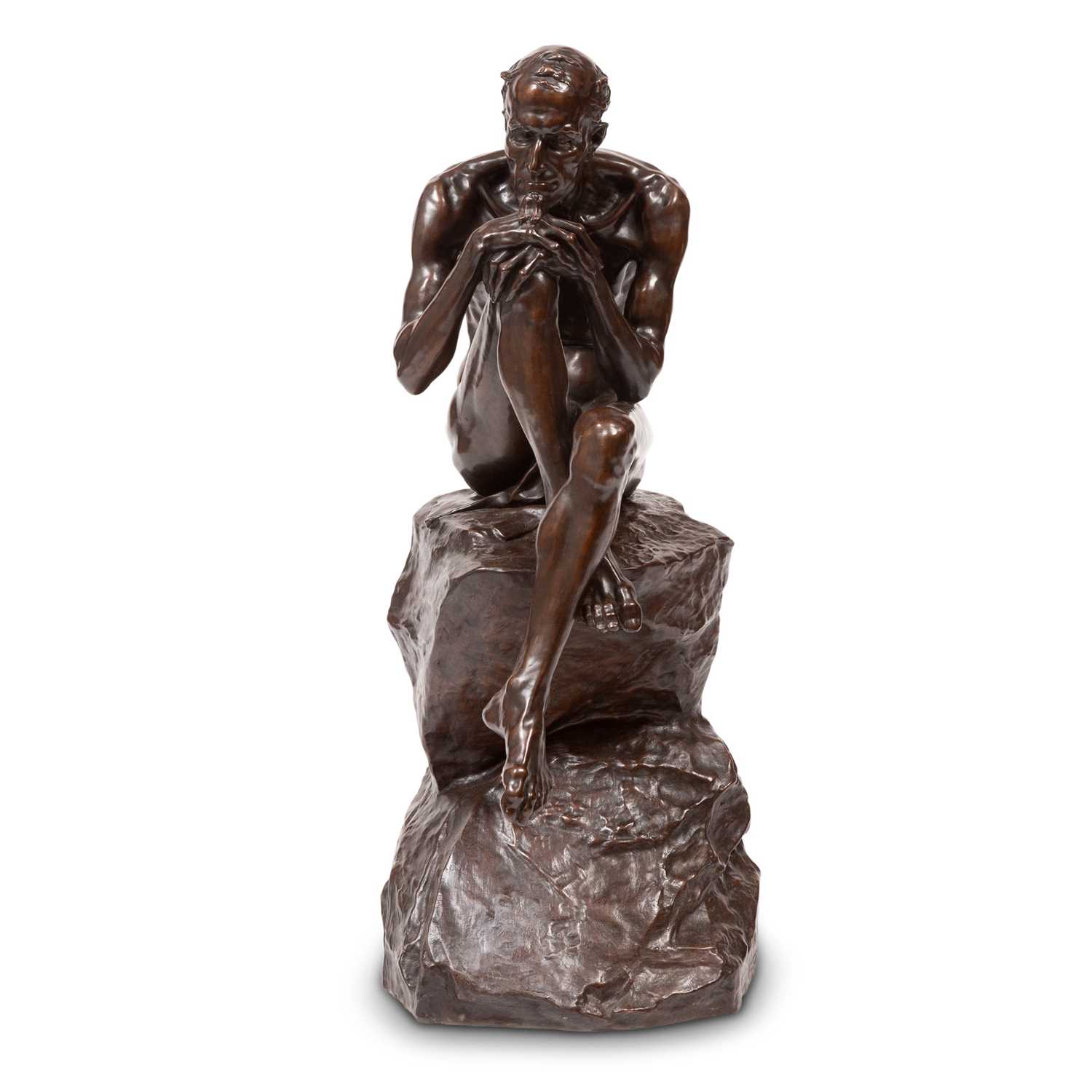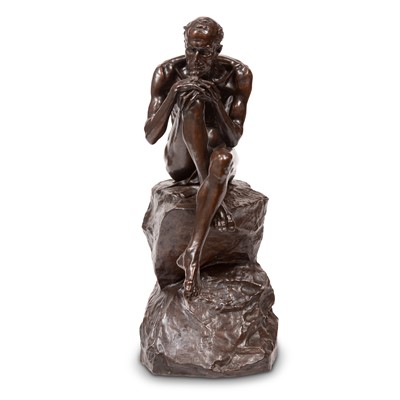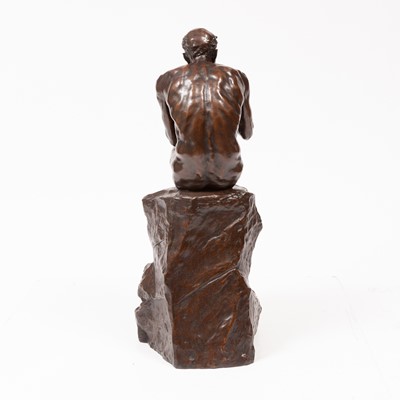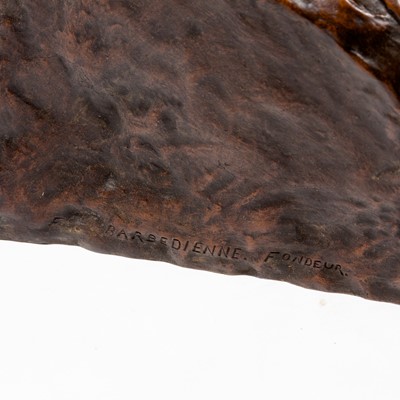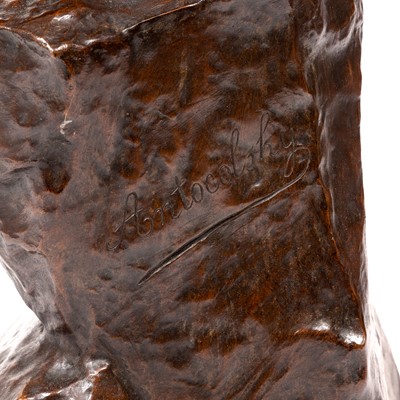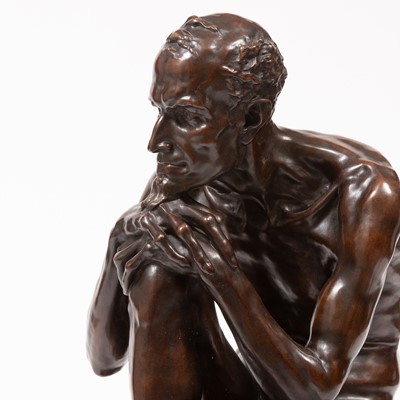Jan 24, 2024 10:00 EST
Fabergé & Vertu / English & Continental Silver
128
Mark Antokolsky (Russian, 1843-1902)
Mephistopheles
Signed Antocolsky, with F. Barbedienne Foundry mark on the base
Bronze with brown patina
Height 33 1/2 inches (85 cm).
Sold for $70,350
Estimated at $30,000 - $50,000
Includes Buyer's Premium
Mephistopheles
Signed Antocolsky, with F. Barbedienne Foundry mark on the base
Bronze with brown patina
Height 33 1/2 inches (85 cm).
Notes:The premier Russian sculptor of the late nineteenth century, Mark Antokolsky (1843-1902) was born in Vilnius and studied at the Imperial Academy of Arts in St. Petersburg under the tutorship of N. Pimenov and I. Reimerce. He was awarded silver medals for his work at the academy, and when his sculpture of Ivan the Terrible was purchased by Emperor Alexander II for the Imperial Hermitage, Antokolsky was given the title of Academician.
Antokolsky conceived of Mephistopheles in 1874 while working on Christ Before the Judgment of the People, aiming to create a character as strong as Christ but in complete moral opposition to him, with the intention of exhibiting the two works together. Concerned as he was with the problems of humanity, Antokolsky considered the process of artistic creation as the embodiment of moral principles. And as with his works, Ivan the Terrible and Peter I, Antokolsky sought to embody both the dark and the light aspects of human nature.
While developing the concept of Mephistopheles in the succeeding years, Antokolsky was inspired by Goethe's Faust, and in 1876 he produced a bust as a study for a full-scale work. However, we was unsatisfied with the result, as he felt it lacked depth and complexity. In 1882, Antokolsky began to produce clay studies of the full-scale work and continued throughout 1883. The finished work, a thoroughly modern and deeply psychological portrait, was realized in marble and cast in bronze.
“My Mephistopheles,” Antokolsky wrote in a letter to E.G. Mamontov in May 1883, “is the product of all ages, especially our age. My Mephistopheles is mystery, plague, decay, which is carried in the air; it infects and kills people. Mephistopheles is evil, fathomless evil, evil without mercy. He is helpless in his spirit, but his jealousy, his self-love is strong. He is irritated by everything: joy, laughter, young kisses. He wants everything around him to be gloomy, dead, empty and lifeless as he is himself.”
While Antokolsky had hoped to exhibit Mephistopheles in the Peredvizhniki exhibition in St. Petersburg after its completion in 1883, it was not until 1886 that it was first exhibited publicly in the Imperial Hermitage. The reception was enthusiastic, with critics praising the work and comparing Antokolsky to Repin. The response in Western Europe, where Mephistopheles was later exhibited, was just as favorable. In Vienna in 1898, Antokolsky was awarded a gold medal for the work.
Other casts of Mephistopheles in bronze, by the Barbedienne and Thiébaut Frères foundries, are known. A cast by the Barbedienne foundry of the same size as the present lot is in Muzei Sobranie, Moscow (Inv. No. 3187/IZO). Other versions of Mephistopheles, in both bronze and marble, are in the State Hermitage, the Tretyakov Gallery, the State Russian Museum and the Victoria and Albert Museum. A large-scale cast of Mephistopheles is in the State Russian Museum (Inv. No. CK-1339); further examples of the same scale, both in bronze and marble, are in the State Russian Museum; and a plaster model is in the State Historical Museum of Religion, St. Petersburg (Inv. No. A-252-III).
A comparable bronze cast of Mephistopheles by Barbedienne, of the same size as the present lot, was sold Christie's New York, October 19, 2001, lot 169 and Sotheby's, London, June 6, 2017, lot 438.
In very good condition. Minor abrasions to patina in areas and minor wear at high points.
Any condition statement is given as a courtesy to a client, is an opinion and should not be treated as a statement of fact and our Organization shall have no responsibility for any error or omission. Please contact the specialist department to request further information or additional images that may be available.
Auction: Fabergé & Vertu / English & Continental Silver, Jan 24, 2024
-
Successful Auction of Fabergé & Vertu on January 24, 2024
-
Bronze Figure of Mephistopheles by Russian Sculptor Mark Antokolsky Achieves $70,400
-
Comprising Lots 1 - 147 in the Sale
-
We Invite You to Contact Us for a Complimentary Auction Evaluation of Your Fabergé & Vertu
NEW YORK, NY -- Doyle's auction of Fabergé & Vertu on January 24, 2024 saw international competition drive strong prices for a range of exceptional objects spanning the 17th to the 20th century. Bidders on both sides of the Atlantic vied for exquisite objects by Fabergé, vertu, silver and icons from prominent collections and estates.
Highlighting the sale was a masterful bronze figure of Mephistopheles by Mark Antokolsky that achieved $70,400, far surpassing its estimate of $30,000-50,000. The premier Russian sculptor of the late 19th century, Mark Antokolsky (1843-1902) conceived of Mephistopheles in 1874 while working on Christ Before the Judgment of the People, aiming to create a character as strong as Christ but in complete moral opposition to him, with the intention of exhibiting the two works together. In 1882, Antokolsky began to produce clay studies of the full-scale work and continued throughout 1883. The finished work, a thoroughly modern and deeply psychological portrait, was realized in marble and cast in bronze.
“My Mephistopheles,” Antokolsky wrote in a letter to E.G. Mamontov in May 1883, “is the product of all ages, especially our age. My Mephistopheles is mystery, plague, decay, which is carried in the air; it infects and kills people. Mephistopheles is evil, fathomless evil, evil without mercy. He is helpless in his spirit, but his jealousy, his self-love is strong. He is irritated by everything: joy, laughter, young kisses. He wants everything around him to be gloomy, dead, empty and lifeless as he is himself.”
A Walkabout with the Specialist
Mark Moehrke examines the bronze figure of Mephistopheles by Russian sculptor Mark Antokolsky. View the Video
We Invite You to Auction!
Consignments are currently being accepted for future auctions. We invite you to contact us for a complimentary auction evaluation. Our Specialists are always available to discuss the sale of a single item or an entire collection.
For information, please contact:
Mark Moehrke: 212-427-4141, ext 272, Mark.Moehrke@Doyle.com
